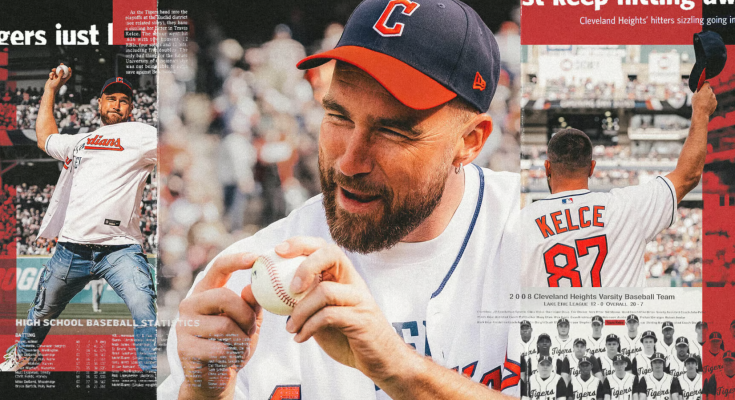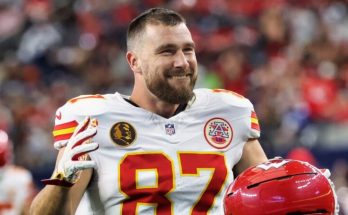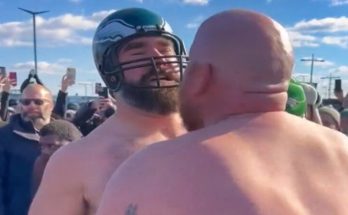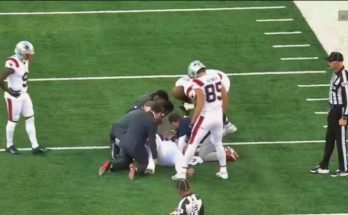A tour through Travis Kelce’s baseball era
In the folkloric story of Travis Kelce’s life and career, one time period stands out. It was the summer of 2010. Kelce had lost his scholarship at Cincinnati after smoking marijuana and failing a drug test. He was living with his older brother, Jason, working for a call center, tasked with asking random people about Obamacare, often enduring scorn from the other end of the phone. At 20 years old, Kelce wondered if his football career was over.
That’s when Kelce, his future hanging in the balance, joined a summer collegiate baseball league. It was a way to stay busy and also a potential Plan B.
As Taylor Swift fans would discover years later while scouring Kelce’s old tweets, there was a time when people in Cleveland Heights, Ohio, viewed baseball as Kelce’s best sport. His father, Ed, loved the game and coached Travis from T-ball on up. And Kelce’s affection for baseball never really faded. Over the years, he has thrown an ill-fated first pitch at a Guardians’ game, played in a celebrity softball contest, stepped in the Chicago Cubs’ batting cages, filmed a video taking hacks with Aaron Judge and attended Game 1 of this year’s World Series.
I can’t wait for this baseball to get started up!!! A lot of people don’t know, but baseball just might be my best sport!
— Travis Kelce (@tkelce) May 28, 2010
During that transformative summer of 2010, Kelce joined coach Michael Bricker’s team at Champions Academy in Cincinnati. One evening, former Cincinnati Bearcats baseball coach Brian Cleary ventured to see Kelce — a player he already knew plenty about — in person.
“He was playing right field. As they take in-and-out (warmups) and as he’s playing pregame, it’s the best thrower of a baseball I’ve ever seen, to this day, in my life,” said Cleary, now a scout for the Washington Nationals.
The lost stories of Kelce’s baseball career, resurrected largely thanks to his girlfriend’s most fervent fans, are worthy of a Swiftian refrain:
If one thing had been different
Would everything be different today?
In 2006, Michael Dillon had just taken over as the head baseball coach at Cleveland Heights High School. It was the summer before Kelce’s junior year, and Dillon’s athletic director had given him a list of the school’s baseball players. After conferring with a few folks in the local baseball scene, Dillon learned of a notable omission: Travis Kelce.
Dillon heard about this kid who moved with the violent grace of a full-on rainstorm, who could hit the ball a mile and who had been throwing 90 mph since the eighth grade. Dillon tracked down the schedule for Kelce’s summer team. He ventured to a game, and one of the first things he saw was Kelce blasting a line-drive to the base of a wall 400 feet from home plate.
“I’m like, ‘What the f—?” Dillon said. “I’m pissed at this AD. How and why was he not telling me about Travis Kelce?”
Kelce was a three-sport star, a quarterback on the football team and a rim-rattling post in basketball. He was also a dominant youth hockey player and even had a stint playing lacrosse in middle school. Although he didn’t play baseball during his sophomore season for Cleveland Heights, Kelce was still spending his summers on a diamond, and his father had been trying to convince his youngest son to go all-in on baseball. Ed had at one point contacted Reggie Sanders, a Cleveland Heights alum turned Braves scout who ran tryout camps in the area. Sanders (not the former major-league player with the same name) answered the phone and almost immediately began rolling his eyes.
Papa Kelce was telling him how talented his youngest son was, how he was always trying to follow in his older brother’s footsteps. (Jason Kelce was already playing football at Cincinnati.) Ed thought his younger son was an even better athlete.
“I was probably putting the phone down,” Sanders said, “grabbing a cup of coffee and then coming back. Like, ‘Whatever bro. I hear this all the time.’”
Sanders, despite his skepticism, went to watch Travis play.
“He looked like Josh Hamilton,” Sanders said, referencing the 2010 American League MVP. “I saw him get a base hit. He got on first, stole second and then stole third way before the catcher could even get it out of his glove. It was something surreal.”
anders evolved into a sort of mentor to Kelce, and kept in close touch with Ed.
“I think that was his father’s dream, to see him in a major-league baseball uniform playing in the World Series,” Sanders said.
View this post on Instagram
The ensuing winter, Dillon stopped Kelce following a basketball practice and made a sales pitch that amounted to a guilt trip.
“You’re the best football player in the school,” Dillon told him. “You’re the best basketball player in the school. You’re out there playing with your teammates and your friends, helping them be successful. Now you don’t play baseball? What is it? Some of your best friends are on the baseball team. You’re gonna be letting them down. You’re gonna be letting the school down. You’re gonna be letting yourself down.”
Kelce always had an undying loyalty to his hometown, a diverse suburb east of downtown Cleveland.
“I’ll be there, Coach,” Kelce told him.
Kelce, who had been academically ineligible for football as a sophomore, first had to raise his grades and ACT score. But midway through his junior season, he was finally able to join the baseball team.
Early in Kelce’s first game, teammate Evan Knoblauch was playing center. A batter from the opposing team smashed a ball over Kelce’s head in left. Knoblauch recalls Kelce yelling out: Oh s—!
Then Kelce turned and started sprinting. He atoned for his bad jump, turned his back to home plate and snagged the ball with a spectacular basket catch. In center field, Knoblauch clapped.
“Man,” he remembers thinking. “Good to have him back.”

By May of Kelce’s senior year, he made The (Cleveland) Plain Dealer as a player of the week. He went 14-for-22 with 12 runs scored, five doubles, two home runs, four steals and 12 RBIs.
The “About Travis” section below his statistics noted Kelce was a fan of the Cleveland Indians and Cavaliers. His favorite movie was “Talladega Nights.” His favorite actor was Will Ferrell. He enjoyed eating at Outback Steakhouse and watching “SportsCenter.” He was a typical teenager.
By his senior season at Cleveland Heights, Kelce had also become the best hitter in the area. Playing mostly outfield and third base, he led the area with a .588 batting average and belted six home runs. Dillon was an early adopter of swinging with a slight uppercut and viewed unlocking even more of Kelce’s monstrous power as a work in progress.
“He would have been an Aaron Judge-type player,” Dillon said.
Kelce even made a few appearances as a closer and was an imposing flamethrower. But his pitching appearances were limited, and teammates tried to avoid facing him in practice for a reason. Years later, no one was totally surprised when he spiked his ceremonial first pitch at the Cleveland Guardians’ home opener.
“He didn’t really always know where it was going to go,” Dillon said.
Kelce also had a reputation for being, well, a goofball.
Some of the stories verge on the apocryphal, and Kelce himself doesn’t mind playfully amplifying them. Sure, Kelce texted his old friend Knoblauch when he was contacted for this story: “Tell him about the legend of 6-6.”
Travis Kelce is a large man. But at a certain point, his outsized reputation exceeded even his actual stature, culminating in the so-called “Legend of 6-6,” a catchphrase for Kelce deeds both good and bad. It would come up when he did something amazing. It could even be a fallback when Kelce did something idiotic. Teammates might shrug and joke: He’s 6-6. Someone that size can get away with anything.
Perhaps, however, his deeds only made him seem that big. As Kelce recently told Knoblauch: “I’m 6-4 7/8.”
On at least one occasion, after the team finished in and out, Kelce would grab the ball, and instead of bringing it into the dugout, he hurled it over the right-field fence.
“He wants a laugh. You tell Trav to do something, Trav would f—— do it,” Knoblauch said.
But he was a goof who was intensively competitive. In a game against rival Beachwood, Kelce came in as the closer. Cleveland Heights was up by two runs. But Kelce was especially wild that day. He issued three walks and gave up a double. The bases were loaded in a tie game when Kelce plunked the opposing batter, hard.
“Right in the neck,” Knoblauch said.
The winning run scored. Kelce walked off the field, took off his glove and hurled it over the fence above the third-base dugout. The glove sailed into the stands on the nearby football field. (“Travis Kelce is the poorest and sorest loser I’ve ever been around,” Cleveland Heights basketball coach Barry Egan once told The Athletic).
Kelce then stomped into the dugout, where a 50-gallon metal drum was serving as the trash can. He grabbed the barrel and tried to hurl it in frustration.
“I’m running in from left field, and I have an obscured view,” Knoblauch said. “All I see is two legs sticking out of the dugout.” Kelce had tried to throw the trash can, flipped, fell over and bruised his ribs.
Later, on the bus ride home, Kelce told his teammates he was sorry and that he had let them down. Too bad no one could contain their laughter.
The summer before they departed for college, Kelce ended up pulling Knoblauch onto a summer team called the East Side Thunder.
“He vouched for me,” said Knoblauch, who went on to play baseball at Denison University in Ohio. “The cool thing about Trav is he still does this now. He introduces people to people.”
It was the spring of 2010 at the University of Cincinnati, and Ed Kelce called Brian Cleary.
Travis had just finished his redshirt freshman season on the Bearcats football team. Now he was suspended for that failed drug test.
As Kelce recounted to Vanity Fair this past summer, Kelce hit Bourbon Street when the Bearcats were playing in the Sugar Bowl. He was listening to Lil Wayne. “And I wanted to smoke what he was smoking,” Kelce told the magazine. After a few days of partying, Kelce and his teammates were called in for an NCAA drug test.
Kelce knew he was screwed.
A few months earlier, Cleary was walking down an athletic department hallway when he bumped into football coach Brian Kelly and asked him: What if Travis Kelce played baseball in the spring?
“I could not get the sentence out of my mouth,” Cleary said, “before he said ‘Absolutely not.’”
But Kelly had left for Notre Dame. Kelce was suspended for a year; new football coach Butch Jones kicked Kelce off the team and revoked his scholarship.
“It was like my life was over,” Kelce told the Wall Street Journal this fall.
Ed was trying to help his exiled son.
“Is there any way,” Ed asked Cleary, “you can set him up with a way to play baseball?”
Ed had a similar conversation with Dillon, and a few connections led them to Michael Bricker and Champions Academy. The local baseball facility had a collegiate summer league that played most of its games around the area, meaning Kelce could still work out and take summer classes.
Dillon called Bricker and convinced him to set up a workout. “I finally got him to understand that this guy, he’s worth a look at,” Dillon said.
Not long after, he was starting in right field against other college players.
Reviews vary on the caliber of competition. But Ed was soon calling Dillon during games, excited at how well his son was playing. The closest thing to a historical record comes from Kelce’s hilarious tweets in the summer of 2010.
June 5, 2010: Aftger game game 1 I’m batting .1000 gotta keep it going through the double header tomorrow
July 3: 3 for 3 with a double, triple, a sacrifice fly and 3 rbi’s, glad I could put on a show for my mom and pops! Feeling good!
July 14: 2 for 4 with a pair of singles and 2 RBI’s which is solid but not what I want, gotta do better on saterday! Now its time to grab some food!
Kelce left an impression in more ways than one. “One of the two or three funniest guys I’ve coached in 20 years,” Bricker said.
Bricker had worked as a scout for the Chicago Cubs and Chicago White Sox. He had even evaluated Michael Jordan, another athlete whose father loved baseball.
“Had pro tools,” Bricker said of Kelce. “He had a major-league arm, major-league speed. He fielded the ball well and hit for power. The only tool that would remain to be seen would be hitting for average. He could really square up a fastball and hit it a long way.”
Bricker notes that Kelce struggled against breaking balls. He had another flaw, too.
“He didn’t like the bunt sign,” Bricker said. “He liked to shake that one off.”
Travis Kelce hitting dingers with Aaron Judge @tkelce @TheJudge44 pic.twitter.com/Va8g8kn29s
— BBQ Dom (@RealBBQDom) April 12, 2023
Kelce knew his game needed work, so he again reached out to Sanders, who was based in Arizona. Kelce was interested in coming down to work out.
“He never wanted me to forget about him. He always stayed in touch. He wanted a Plan B,” Sanders said. “He was like, ‘Bro, I don’t know about this football thing.’ He was not really thinking the football thing was going to work out.”
Cleary is unsure how Kelce would have fared against high-level pitching, but knows he could have played at Cincinnati. Sanders believes Kelce could have been a second- or third-round pick, and perhaps a top prospect had he grown up in a warm-weather state and played consistently.
Bricker ended that summer with an even stronger review: “Kelce could have been another Kirk Gibson had he stayed at baseball. Kirk Gibson could have been a good receiver, tight-end type guy. I think they both chose good career paths.”
Kelce, who declined to talk for this story, never played baseball at UC. His suspension didn’t end until Jan. 1, 2011. By then he was geared up for a return to football. And — after spending a year attaining a 3.2 GPA — a position switch from quarterback to full-time tight end became the invisible string tying him to his destiny.
“I think from that point on the writing was on the wall for him as a football player,” Cleary said. “He never made it on the field for us, but it wasn’t for lack of trying on his part or our part.”
The closest Kelce came to the majors was throwing out two ceremonial first pitches. The first was this past April at Cleveland’s Progressive Field, a ball that went straight into the turf. In June, the Royals gave him a shot at redemption.
That is when Kelce toed the rubber, went into a brief windup and threw a ball that caught the inner edge of the plate. As the ball hit Bobby Witt Jr.’s mitt, Kelce held a pose on the mound. Then he pointed and motioned as if it were a called strike.




